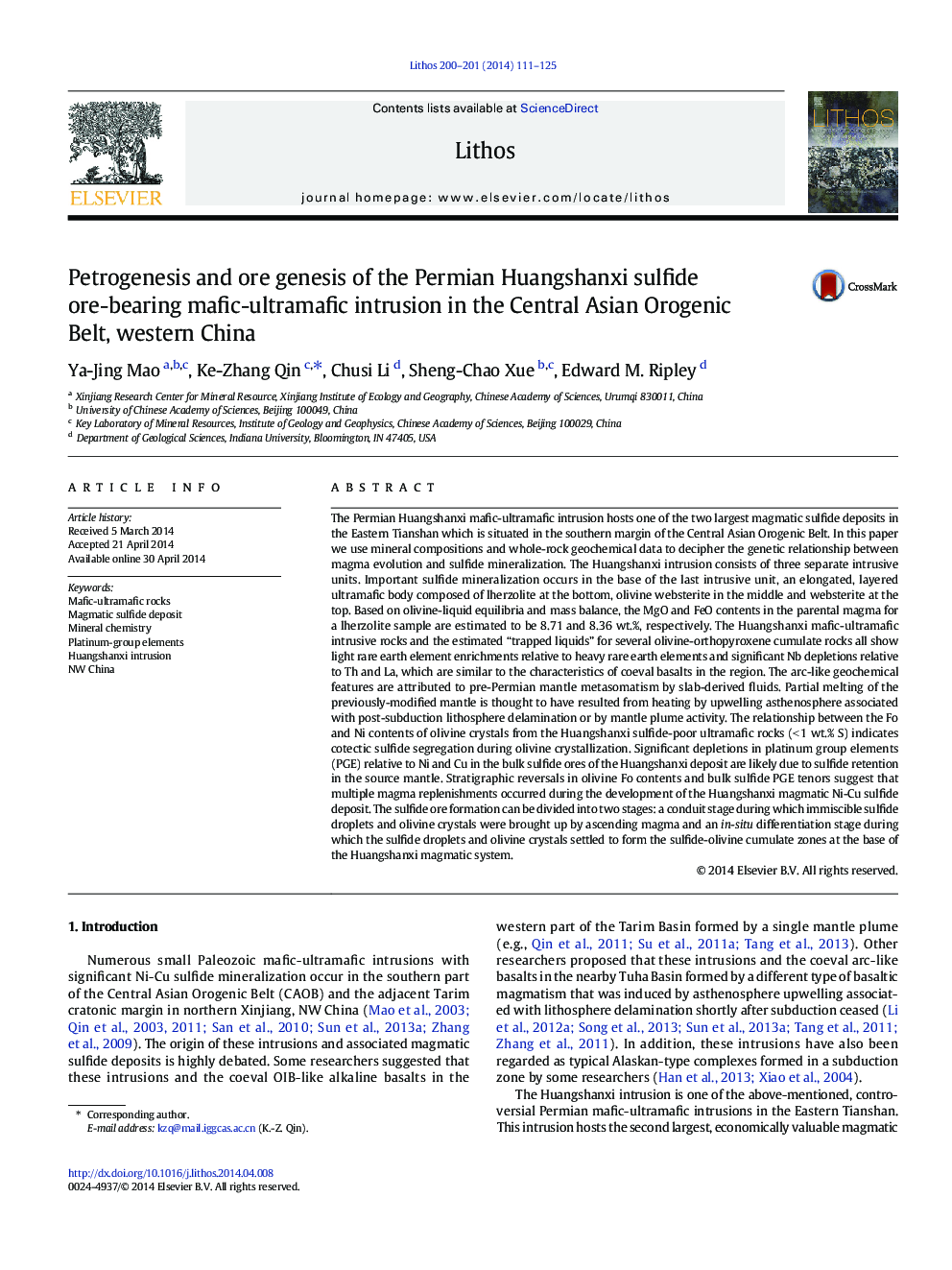| کد مقاله | کد نشریه | سال انتشار | مقاله انگلیسی | نسخه تمام متن |
|---|---|---|---|---|
| 6440796 | 1638676 | 2014 | 15 صفحه PDF | دانلود رایگان |
عنوان انگلیسی مقاله ISI
Petrogenesis and ore genesis of the Permian Huangshanxi sulfide ore-bearing mafic-ultramafic intrusion in the Central Asian Orogenic Belt, western China
دانلود مقاله + سفارش ترجمه
دانلود مقاله ISI انگلیسی
رایگان برای ایرانیان
کلمات کلیدی
موضوعات مرتبط
مهندسی و علوم پایه
علوم زمین و سیارات
ژئوشیمی و پترولوژی
پیش نمایش صفحه اول مقاله

چکیده انگلیسی
The Permian Huangshanxi mafic-ultramafic intrusion hosts one of the two largest magmatic sulfide deposits in the Eastern Tianshan which is situated in the southern margin of the Central Asian Orogenic Belt. In this paper we use mineral compositions and whole-rock geochemical data to decipher the genetic relationship between magma evolution and sulfide mineralization. The Huangshanxi intrusion consists of three separate intrusive units. Important sulfide mineralization occurs in the base of the last intrusive unit, an elongated, layered ultramafic body composed of lherzolite at the bottom, olivine websterite in the middle and websterite at the top. Based on olivine-liquid equilibria and mass balance, the MgO and FeO contents in the parental magma for a lherzolite sample are estimated to be 8.71 and 8.36Â wt.%, respectively. The Huangshanxi mafic-ultramafic intrusive rocks and the estimated “trapped liquids” for several olivine-orthopyroxene cumulate rocks all show light rare earth element enrichments relative to heavy rare earth elements and significant Nb depletions relative to Th and La, which are similar to the characteristics of coeval basalts in the region. The arc-like geochemical features are attributed to pre-Permian mantle metasomatism by slab-derived fluids. Partial melting of the previously-modified mantle is thought to have resulted from heating by upwelling asthenosphere associated with post-subduction lithosphere delamination or by mantle plume activity. The relationship between the Fo and Ni contents of olivine crystals from the Huangshanxi sulfide-poor ultramafic rocks (<Â 1Â wt.%Â S) indicates cotectic sulfide segregation during olivine crystallization. Significant depletions in platinum group elements (PGE) relative to Ni and Cu in the bulk sulfide ores of the Huangshanxi deposit are likely due to sulfide retention in the source mantle. Stratigraphic reversals in olivine Fo contents and bulk sulfide PGE tenors suggest that multiple magma replenishments occurred during the development of the Huangshanxi magmatic Ni-Cu sulfide deposit. The sulfide ore formation can be divided into two stages: a conduit stage during which immiscible sulfide droplets and olivine crystals were brought up by ascending magma and an in-situ differentiation stage during which the sulfide droplets and olivine crystals settled to form the sulfide-olivine cumulate zones at the base of the Huangshanxi magmatic system.
ناشر
Database: Elsevier - ScienceDirect (ساینس دایرکت)
Journal: Lithos - Volumes 200â201, July 2014, Pages 111-125
Journal: Lithos - Volumes 200â201, July 2014, Pages 111-125
نویسندگان
Ya-Jing Mao, Ke-Zhang Qin, Chusi Li, Sheng-Chao Xue, Edward M. Ripley,